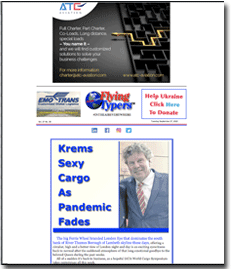 |
We
recently caught up with friend and occasional contributor, Austin, TX-based
air cargo consultant Michael (Mike) Webber who consults for international
gateways in North America, and has completed projects in Latin America,
Asia, Africa and the Middle East. Clients and journalists value his willingness
to tell what they need to know, rather than simply what they want to hear.
FlyingTypers: We
hear you have been consulting for various airports. Anything you can share?
What are you seeing generally at U.S. airports?
MW: The
number and scale of cargo development opportunities in the U.S. pipeline
are unprecedented. Near-comprehensive redevelopment at LAX and JFK, ongoing
cargo efforts at DFW, ATL, PHL, ORD and MIA. Five of those rank in the
U.S. top ten cargo airports. All seven rank in the top twenty!
FT: It
wasn’t always like this!
MW: Between
2001 and 2015, much of the cargo facilities development at U.S. airports
was replacement, not expansion. A lot of obsolete surplus capacity was
created by closures of BAX Global, Emery Worldwide, Kitty Hawk and others.
DHL acquired Airborne Express, leading to many more redundancies. And
the demand that e-commerce created in recent years was not for 40–50-year-old
legacy facilities.
FT: Do
the old planning approaches still apply?
MW: In
some cases. Where enough land exists that cargo facilities improvements
can proceed while all tenants operate in-place, agreeable alternatives
can be considered. At legacy gateways where capacity is full and available
land is scarce to nonexistent, the principal objective is to sequence
development to interfere with existing operations as little as possible.
As an airport planner and for our airport clients, it can feel a little
like triage. One just tries to make communications as timely and be as
responsive as possible. Even when we must tell people what they don’t
want to hear, the sooner cargo operators know it, the better. At legacy
hubs, that may mean infuriating dozens of airlines and handlers.
Most legacy hubs are not going to get more
land and are approaching absolute ceilings on operations. Therefore, they
must do more with capacity that remains. This means replacing outdated
facilities that often are fully capitalized with state-of-the-art construction.
The emphasis is value, rather than cost. More throughput is required to
pay for 21st century construction. Operations must be much more efficient.
Technology can help but it’s not a magic bullet. It can be surprising
how little some airport operators and their tenants understand about the
other side’s business models. I can’t make everyone happy,
but I am committed to having each side understand the impacts of their
actions and decisions.
FT: Where
else are you working?
MW: I’m
consulting for Denver International Airport (DEN) and Milwaukee’s
General Mitchell International Airport (MKE). Earlier in the year, I subbed
with InterVISTAS to complete a study for Halifax Stanfield International
Airport (YHZ).
FT: If
you’ve seen one airport . . .
MW: You’ve
seen one airport. These three airports and markets are different from
one another and from the gateways we’ve been discussing. DEN is
an international gateway and among the biggest passenger airports in the
world but relatively light on freighters, apart from integrators and Amazon.
DEN has thousands of acres of greenfield sites available for development,
so relatively few constraints.
Halifax could be a case study for how local
communities support international service – freighters to both Asia
and Europe – based on a niche which happens to be North America’s
finest lobster exports. The Province (Nova Scotia), the local community
and airport operator have collaborated beautifully to make sensible investments
toward its goals.
Like my native Kansas City, Milwaukee has
a familiar Midwestern spirit. Challenging
market area that overlaps with two top twenty cargo airports - Chicago
and Rockford - but Milwaukee has a solid O&D (origin and destination)
market of its own. FedEx uses it as a mini-hub to serve smaller markets
with regional feeder flights to markets like Green Bay.
FT: You’ve
been doing this for decades but still seem to enjoy yourself.
MW: I
am! The pandemic limited what I typically enjoy most, which is visiting
the cargo facilities and listening to carriers, handlers and forwarders
all day and then in the evenings, finding live music clubs to hear local
talent. I find locally-owned restaurants and book stores. I used to talk
to Chris Foyle about that. I don’t play golf, so at conferences,
I have my own thing going. As you well know, having participated in my
outings.
FT: What
events have you been attending?
MW: I
just spoke on a panel for the Airforwarders Association at an event hosted
by American Airlines in their relatively new headquarters at DFW. I’ve
done some planning in the past for DFW and that airport has consistently
had one of the most entrepreneurial management teams – through multiple
directors.
They’re doing a cargo redevelopment
at the location where DFW’s original cargo buildings were built
in the 1970s. Airport management is doing a lot more for themselves, but
they have unusual assets. Before joining DFW, Al Kalmbach previously worked
for (air cargo facilities developers) Aeroterm and Prologis and even earlier,
for American Airlines’ properties. So, he’s a “ringer”
in terms of commercial real estate. DFW’s not a client of mine anymore
but I’m always interested in past clients too.
Of course, Brandon Fried was the panel moderator.
I first met Brandon about twenty years ago when we were on the air cargo
security working groups established by Homeland Security after 9/11. Not
many Beltway trade associations are led by individuals who worked in that
industry, but Brandon was a forwarder and retains all that experience
while leading that organization. I am a paying member of the Airforwarders
Association, although unlike Brandon, I, myself, have never been a forwarder.
FT: How
did that happen then?
MW: I’ve
always admired Brandon’s leadership style. I’ve associated
with other air cargo associations and have seen how well Brandon collaborates
with others while ensuring that his members’ priorities are served.
Even before I joined the AfA, Brandon asked me to participate in their
Airport Congestion Task Force, which demonstrated his commitment to simply
gather the right mix of experiences.
FT: Do
you work with any other trade associations?
MW: I
moderated a session for TIACA at their meeting in San Francisco early
this year. Glyn has done a magnificent job leading that organization.
Of course, Steven Polmans has been a very effective Chairman, as well.
They are the right people for that organization precisely when it needed
them most. I always enjoyed Glyn at IATA, and I think he’s taken
the best of that experience to TIACA while blazing a path that is neither
the same old TIACA nor IATA. I’m thoroughly impressed by what he’s
doing there.
FT: We
saw your travelogue last summer as you bounced around Europe visiting
airport operators. Anything you can tell us about that?
MW: That
was a 3-week European vacation, but I took advantage of the opportunity
to meet with the cargo teams from Amsterdam, Cologne, Liege and Brussels,
as well as meet with NACO (Netherlands Airport Consultants) in The Hague,
as well as Nallian whose Cargo Cloud platform helps coordinate cargo activities
at BRU and numerous other airports.
FT: Did
you pick up any business?
MW: No,
and that wasn’t the specific motivation either. I’d visited
with the cargo teams from AMS and BRU, as well as the Nallian team, recently
at cargo conferences at MIA and SFO, so was glad to continue those conversations
on their home turfs. I’d never actually been to CGN or LGG but have
read so much about those two airports over the years, so was delighted
to see them in-person. I partner a lot with InterVISTAS which is a subsidiary
of NACO. Everyone with whom I met was infallibly hospitable and I just
still enjoy the opportunity to swap ideas and experiences with professional
colleagues. I was very interested about the cargo community systems and
also the cargo teams in Europe because at many U.S. airports, there may
not even be a dedicated cargo professional, let alone a team.
FT: What’s
next?
MW: I
am putting together a webinar series that I’ll host – or possibly
co-host – that will allow me to focus on a specific subject and
guest to a degree that one simply can’t otherwise. I am grateful
for the opportunities I get to moderate or be a panelist at conferences,
but organizers usually have to be somewhat broader in their subjects and
have a slate of panelists. I have helped organize enough conferences to
understand the challenges and I know why they’re organized in that
manner but what I want to do is just have a single guest and we’ll
talk in detail about narrow topics – like ULD storage – for
most of an hour. It will be free, so we won’t have to worry about
whether listeners get their money’s worth.
There are plenty of subjects in which many
of my airport clients have very little visibility but will likely be making
policy decisions in the near future regarding capacity management. This
will be an opportunity for them to hear the impressions directly from
the operators, rather than only through their consultant. Some of the
individuals with whom I met in Europe will undoubtedly be guests. I am
looking forward to it but it must wait until I am no longer involved with
a couple of ongoing projects.
FT: After
doing this for about thirty years, you sound like you’re just getting
started!
MW: No,
I am winding down but there are a few things I want to do first that leverage
my abilities and experiences. I am excited by the evolution of our industry
and glad for some of the changes. I spoke last year at a global logistics
conference hosted by the University of Southern California where I met
so many college students studying logistics – often in tandem with
studies in robotics and other disciplines. I was so invigorated by meeting
them and seeing all that youthful enthusiasm. For all the talk about how
to attract young people into our industry, I left that conference wondering
“have you tried going where the young people are and talking to
them?”
FT: None
of this sounds at all like “winding it down”.
MW: I
am. I feel very grateful and fortunate to have had the experiences I’ve
had and met so many people who’ve become dear to me. My 40th high
school reunion is coming up in Kansas City and in some ways, going to
recent conferences after the pandemic stirred the same emotions in me.
It turns out that I care a lot more about professional colleagues than
perhaps I’d realized before I’d lost access to them for a
while. Growing up in a Kansas City suburb, I had no idea that I’d
get to ride a camel in Cairo and do so many other things I’ve done.
It’s been great but it’s approaching time for me to go do
something else.
FT: Speaking of doing
other things: When we checked a year ago, you were making a music documentary.
How is that going?
MW: A
documentary producer told me “When you’re absolutely sure
you’re finished making a documentary, you’re halfway there”.
We’ve worked on this for two years already and have over a hundred
hours of interviews in the can but probably have another year to go. I’m
not complaining. We’ve interviewed the coolest people any music
(particularly 1970s Punk Rock) fan could hope to meet. It’s
taking so long precisely because the story is so rich that we just keep
finding more angles that must be explored. Here’s a link to the
teaser. It’s
a 1970’s Punk Rock band, so language may not be suitable for office
environments.
|





